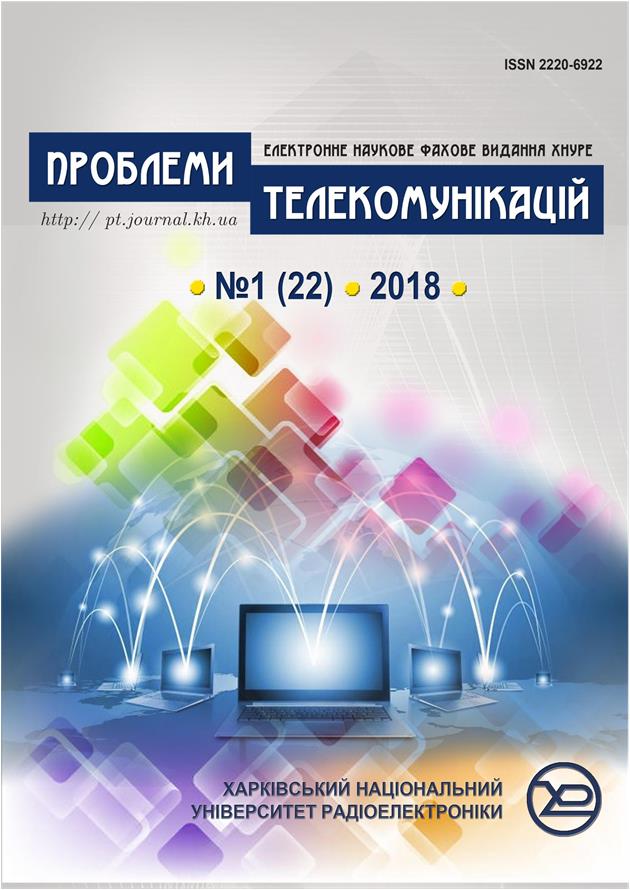Исследование информативности фазовых данных голосового сигнала пользователя системы аутентификации
DOI:
https://doi.org/10.30837/pt.2018.1.05Анотація
У роботі досліджуються напрямки підвищення ефективності сучасних систем голосової аутентифікації в різних системах доступу. Один з основних напрямків підвищення ефективності розглянутих систем аутентифікації пов'язаний з використанням фази голосового сигналу. Об'єктом дослідження є процес цифрової обробки сигналів у системах голосової аутентифікації. Вирішується наукове завдання формування й використання фазових даних голосового сигналу системи аутентифікації. Метою досліджень є оцінка інформативності фазових даних голосового сигналу й визначення їхніх основних характеристик. Якісна й кількісна оцінка формантної інформації амплітудного й фазового спектрів підтвердила гіпотезу про більшу інформативність фазових даних. Представлені результати досліджень доцільно використовувати в системах голосової аутентифікації, удосконалювання систем розпізнавання мови, а також при рішенні завдань ідентифікації диктора.Посилання
“Otchet Cisco po informacionnoj bezopasnosti za 2018 god [Cisco 2018 annual cybersecurity report].” Cisco. 2018. https://www.cisco.com/c/dam/global/ru_ru/assets/offers/assets/cisco_2018_acr_ru.pdf.
BEIGI, H. Fundamentals of Speaker Recognition. NY: Springer, 2011.
OPPENHEJM, A.V.; LIM, DZH.S. “Vazhnost' fazy pri obrabotke signalov [The importance of phase in signal processing],” TIIJeR, t. 69, № 5, p. 39–54, 1981. (in Russian).
PAVLENKO, I.S.; PASTUSHENKO, N.S.; FAJZULAEVA, O.N. “Issledovanie fazovyh harakteristik golosovogo signala pol'zovatelja sistemy autentifikacii [Jelektronnyj resurs] [The study of the phase characteristics of the voice signal of the user authentication system],” Problemi telekomunіkacіj, n.2(21), p. 52-60, 2017. http://pt.journal.kh.ua/2017/2/1/172_pavlenko_signal.pdf. (In Russian).
SOROKIN, V.N. “Raspoznavanie lichnosti po golosu: analiticheskij obzor [Voice Recognition: An Analytical Review],” Informacionnye processy, t. 12, № 1, p. 1–30, 2012. (In Russian).
BESACIER, L.; BONASTRE, J.-F. “Subband architecture for automatic speaker recognition,” Signal Process, v. 80, p. 1245–1259, 2000. DOI: https://doi.org/10.1016/S0165-1684(00)00033-5.
LU, X.; DANG, J. “An investigation of dependencies between frequency components and speaker characteristics for text-independent speaker identification,” Speech Communication, v. 50, n. 4, p. 312–322, 2007. DOI: https://doi.org/10.1016/j.specom.2007.10.005.
FANT, G. Akusticheskaja teorija recheobrazovanija. Per. s angl. [Acoustic Theory of Speech Formation]. M.: Nauka, Glavnaja redakcija fiziko-matematicheskoj literatury, 1964. (In Russian).
BENDAT, DZH.; PIRSOL, A. Prikladnoj analiz sluchajnyh dannyh: Per. s angl. [Applied analysis of random data]. M.: Mir, 1989.
Пристатейна бібліографія
Отчет Cisco по информационной безопасности за 2018 год. – 68 с – Режим доступа: https://www.cisco.com/c/dam/global/ru_ru/assets/offers/assets/cisco_2018_acr_ru.pdf.
Beigi H. Fundamentals of Speaker Recognition. – NY: Springer, 2011. – 1029 c.
Оппенхейм А.В., Лим Дж.С. Важность фазы при обработке сигналов // ТИИЭР. – 1981. – Т. 69, № 5. – С. 39–54.
Павленко И.С. Исследование фазовых характеристик голосового сигнала пользователя системы аутентификации [Электронный ресурс] / И.С. Павленко, Н.С. Пастушенко, О.Н. Файзулаева // Проблеми телекомунікацій. – 2017. – № 2 (21). – С. 52 - 60. – Режим доступа к журн.: http://pt.journal.kh.ua/2017/2/1/172_pavlenko_signal.pdf.
Сорокин В.Н. Распознавание личности по голосу: аналитический обзор // Информационные процессы. – 2012. – Т. 12, № 1. – С. 1–30.
Besacier L., Bonastre J.-F. Subband architecture for automatic speaker recognition // Signal Process. – 2000. – V. 80. – P. 1245–1259.
Lu X., Dang J. An investigation of dependencies between frequency components and speaker characteristics for text-independent speaker identification // Speech Communication. – 2007. – V. 50, N 4. – P. 312–322.
Фант Г. Акустическая теория речеобразования / Г. Фант. Пер.с англ. – М.: Наука, Главная редакция физико-математической литературы, 1964. – 284 с.
Бендат Дж., Пирсол А. Прикладной анализ случайных данных: Пер. с англ. – М.: Мир, 1989. – 540 с.
##submission.downloads##
Опубліковано
Номер
Розділ
Ліцензія
Авторське право (c) 2019 Mykola Savelijovych Pastushenko, Vivaldo Gomes Montejro Pedro, Olha Mykolaivna Faizulaieva

Ця робота ліцензується відповідно до Creative Commons Attribution-NonCommercial-ShareAlike 4.0 International License.
Автори, які публікуються у цьому журналі, погоджуються з наступними умовами:- Автори залишають за собою право на авторство своєї роботи та передають журналу право першої публікації цієї роботи на умовах ліцензії Creative Commons Attribution License, котра дозволяє іншим особам вільно розповсюджувати опубліковану роботу з обов'язковим посиланням на авторів оригінальної роботи та першу публікацію роботи у цьому журналі.
- Автори мають право укладати самостійні додаткові угоди щодо неексклюзивного розповсюдження роботи у тому вигляді, в якому вона була опублікована цим журналом (наприклад, розміщувати роботу в електронному сховищі установи або публікувати у складі монографії), за умови збереження посилання на першу публікацію роботи у цьому журналі.
- Політика журналу дозволяє і заохочує розміщення авторами в мережі Інтернет (наприклад, у сховищах установ або на особистих веб-сайтах) рукопису роботи, як до подання цього рукопису до редакції, так і під час його редакційного опрацювання, оскільки це сприяє виникненню продуктивної наукової дискусії та позитивно позначається на оперативності та динаміці цитування опублікованої роботи (див. The Effect of Open Access).

